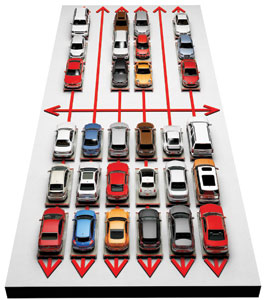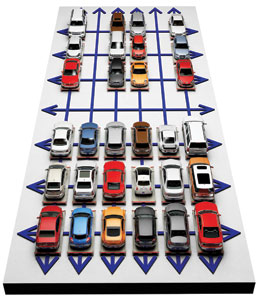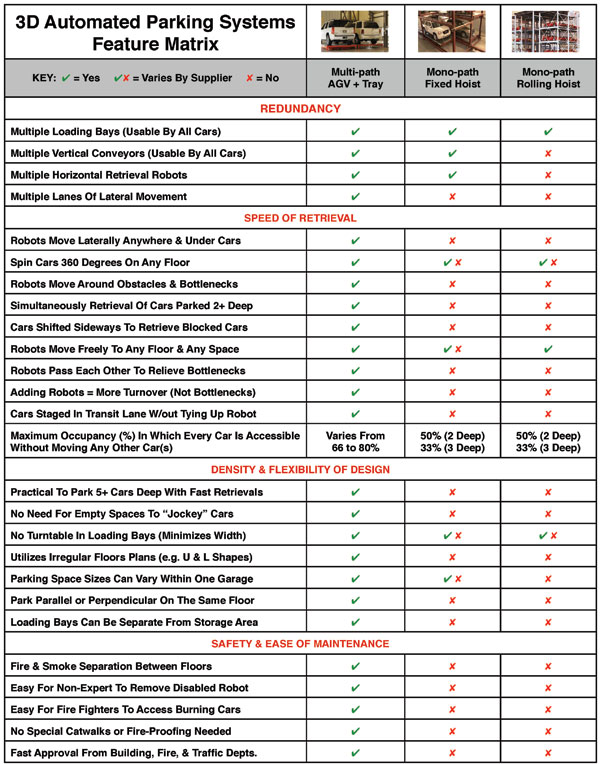Robots Update the Parking Garage
The ability to move laterally anywhere in the garage, enables greater density to be achieved without impacting performance. By way of example, just imagine a grid of nine parking spaces, three across and three deep. The software that controls a multi-path system would be programmed to first park three cars deep in the left and right rows of the nine-car grid—leaving the center row empty and thereby attaining 66 percent occupancy. Since the robots can move a parked car laterally into this still-empty center row, a multi-path system can typically retrieve any car without the need to move any other cars up until this grid (and similarly, the entire garage) exceeds 66 percent occupancy. This is compared to the 33 percent occupancy threshold at which similarly designed three-deep mono-path system starts requiring cars to be moved for retrieval.
 |
 |
Mono-path automated parking systems move laterally along a rail resulting in only one lane of lateral movement, which creates bottlenecks and chokepoints. Images by Boomerang Systems, Inc. |
Multi-path automated parking systems use omni-directional robots to move across concrete slabs (even under parked cars) creating multiple lanes of lateral movement, which enables them to move around obstacles. |
These systems offer the same environmental advantages as first and second-generation mono-path systems, but the multi-path systems provide greater density, reliability, throughput, safety, design flexibility, and are easier to integrate within a larger building.
As a result of these many benefits, these multi-path automated parking systems have been met with very positive response by government fire and building officials and real estate developers leading to a recent surge in their adoption. When compared with earlier first and second generation mono-path systems, it is easy to see why many have concluded that multi-path automated parking systems are much better suited for larger, higher-demand parking garages.
The Impact of Multi-Path AGV-Based Systems on Parking Design
Since a multi-path system's omni-directional robots move at right angles and rotate in place, they can easily park in places that would be impossible using mono-path systems. Instead of being limited to clear rectangular-shaped garages as mono-path systems are, multi-path systems can efficiently park L-shaped, triangular, and irregularly shaped garages, by creating transit aisles that intersect each other and by parking behind obstacles like building support columns, service rooms, elevator cores and staircases. This ability gives multi-path systems the advantage of being easily integrated into buildings without the need to create costly column-load transfers to make more room for the wide turning radii required by human drivers.
Additionally, since there are no drivers exiting the vehicles in the storage area, the vehicles can be parked more closely together, thereby enabling four cars to be parked across approximately the same space between columns that is required to park three cars in a conventional garage.
Summary of Capabilities of Robotic AGV Parking
- No single point of failure.
- No bottlenecks.
- Omni-directional robot rolls across solid concrete decks in multiple lanes of lateral movement without being limited to a single lane of lateral movement as in rail-based systems.
- Can realistically park five or more cars deep versus only two cars deep for mono-path systems.
- Garages have a faster turnover as more robots can be added without causing grid-lock.
- Robots can travel under parked vehicles.
- Nothing touches the vehicle; as the robots lift only the vehicle tray.
- Robots can be easily accessed, repaired and removed for servicing.
- Robots approach vehicles and pick up from front, rear or side.
- Vehicles can be transported in any direction.
- Payload capacity of a robot is approximately 8,300 lb. (7,000 lb. for a car and an additional 1,300 lb. for a tray).
- Saves space because vehicles are rotated at a convenient time without need of a separate turntable, which improves throughput by rotating cars away from the high-demand parking bays.
- Robots are battery operated and recharge automatically when not in use.
- AGV requires low maintenance compared with a mono-path system.
- Robots can travel from floor-to-floor to respond to increased demand on any given floor.
 |
|
The ideal width for ease of operation is 23.25 feet between columns for three cars (highlighted in green), whereas the most efficient is 30 feet between columns for four cars (highlighted in yellow). Source: Boomerang Systems, Inc. |
Drawbacks to AGVs
- In those few remaining municipalities that do not require fire safety measures (such as for catwalks, intumescent paint, fall protection across the entire atrium) mono-path systems can provide a cost advantage over pouring the solid cement floors required to house multi-path systems.
- While increasingly rare, some municipalities may not recognize the levels of a mono-path system as a floor, and thus may exempt them from the developer's FAR (Floor Area Ratio) calculations.
- The concrete slabs in AGV systems prevent visibility through the structure.
- While the use of trays simplifies many things by enabling the AGV to lift the same shaped object every time and protects vehicles from inadvertent damage from machinery, trays do add expense and extra work as they must be stacked when emptied and de-stacked when needed.
 |
Features of three-dimensional parking systems |









